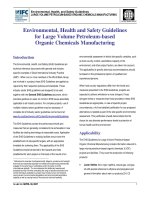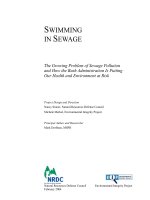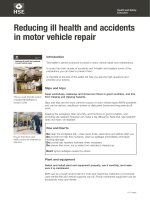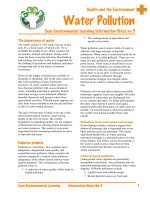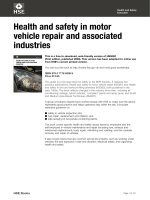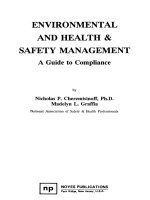Health and safety manual and kit
Bạn đang xem bản rút gọn của tài liệu. Xem và tải ngay bản đầy đủ của tài liệu tại đây (452.01 KB, 86 trang )
Insert Your Company Name
Health & Safety Manual and Procedures
The Health and Safety
Manual and Kit ™
Health & Safety Manual and Procedures
Contents
CONTENTS
(Approx) PAGE
HEALTH & SAFETY POLICY
1.
2.
3.
4.
5.
6.
7.
8.
9.
10.
11.
12.
13.
14.
15.
Organisation And Lines Of Responsibility
Fire Safety
Electrical Safety
First Aid
Training
Cleanliness
Manual Handling
Control Of Substances Hazardous to Health
Protective Clothing
Visual Display Screen Equipment
Machinery
Guarding
Visitors & Contractors
Risk Assessments
Signatures
PERMIT TO WORK
Introduction
Procedure
PROCEDURE FOR THE HEALTH AND SAFETY INDUCTION OF NEW EMPLOYEES AND
AGENCY OR OTHER TEMPORARY WORKERS
Introduction
Recording
Person Responsible
HEALTH AND SAFETY INDUCTION TRAINING FORM: IND1
1
2
2
3
3
3
3
4
4
4
5
5
5
5
5
6
7
7
7
8
8
8
8
9
ACCIDENT/DISEASE/DANGEROUS OCCURRENCES: FORM ACC3
10
RISK ASSESSMENT
11
The Management of Health and Safety at Work
Introduction
Statutory Requirements
Associated Documentation
Arrangements For Health & Safety
First Aid & Accident Reporting
Pregnancy
Company Risk Assessments
12
12
12
12
12
12
12
13
What is a Risk Assessment?
Why are they necessary?
Who should do them?
When should they be done?
How do you perform a risk assessment?
How do you assess risk levels?
Step One
13
13
14
14
14
14
14
Step Two
15
Step Three
15
Step Four
15
Administration
ADDITIONAL CHECKLISTS FOR RISK ASSESSMENT FORM
Potential hazards in the workplace
People affected by hazards
Other specialist areas of assessment
Identified Hazards
RISK ASSESSMENTS: SAFE SYSTEMS OF WORK
Burns from fire
Inhalation of smoke
Burns from electrical/gas plant
Burns from electricity
Burns from hot water
Cuts from plant
Cuts from broken glass
Contact with chemicals
Inhalation of chemicals
Ingestion of chemicals
Falls on slippery floors
Falls on obstructed floors
Falls down stairs/steps
Contact with Electricity
Manual Handling Injuries
Collision with others
Injuries from objects falling
Falls from heights
Burns from Electricity
Escape of gas
Airborne Harmful Substances
Working in Isolation
Handling of hazchem spillage
Bloodborne pathogens
Injury from VDU use
Water Safety and Pathogens
Entanglement with equipment
Contact with equipment
Failure/Collapse of Lifting Equipment
15
16
16
16
17
17
18
18
18
18
18
19
19
20
21
21
21
21
22
22
23
23
24
24
25
25
26
26
27
27
28
28
28
29
29
29
General use of vehicles and vehicle safety
Use and handling of Liquid Petroleum Gas
RISK ASSESSMENT PROCEDURE
1.
2.
3.
Introduction
Risk Assessment
Risk Assessment Procedure
A. Hazards
B. Who is at Risk ?
C Existing Control Measures
D. Proposed Action
E. Record your Findings
4. Review your Assessment Annually
Appendix 1 Risk Assessment Procedure FORM RA1
Appendix 2: Risk Assessment Procedure Form RA2
PROCEDURE FOR THE INSPECTION OF PORTABLE APPLIANCES
1.
Visual Checks By Users
2.
Visual Checks In House
External Testing
ELECTRICAL SAFETY
Introduction
Requirements
MANUAL HANDLING
30
31
32
32
32
32
32
33
33
34
34
34
35
36
37
37
37
38
39
39
39
41
Introduction
Definition
Assessment Procedure
Personal Protective Equipment
Employees‟ Duties
Information, Instruction and Training
Assessment Review
Assessment Manual
41
41
41
41
41
42
42
42
MANUAL HANDLING GUIDANCE NOTE
43
Introduction
Manual Handling Injuries
Duties of Employers
Duties of Employees
SIX STEPS TO CORRECT LIFTING
CHEMICAL SAFETY
Introduction
Assessment Procedure
Assessment Review
43
43
43
43
44
45
45
45
46
WORK EQUIPMENT
Introduction
Definitions
Assessment Procedure
Assessment Review
WELFARE ARRANGEMENTS
Introduction
Requirements
Provisions applicable to the workplace and to equipment, devices and systems therein
PROCEDURE FOR DISPLAY SCREEN EQUIPMENT
Introduction
Definitions
User Identification and Assessment Procedure
47
47
47
47
48
49
49
49
49
55
55
55
55
DISPLAY SCREEN EQUIPMENT
56
Introduction
Screen
The Desk
The Chair
Accessories
Document Holders
Footrests
Mouse
Wrist Rest
Telephone
Adjusting Your Workstation
Work Breaks and Job Design
Eyes and Eye-sight
Eyesight Testing
Glasses
The Work Environment
Lighting
Temperature
Humidity
Noise
Reflections and Glare
Display Screens and Health
Radiation
Cataracts and Epilepsy
Headaches
56
56
57
57
57
57
57
58
58
58
58
58
59
59
59
60
60
60
60
60
60
60
60
61
61
CODE OF PRACTICE FOR CONTRACTORS
CONTENTS
1.1 General Safety Requirements
1.2 Training
62
62
63
63
1.3
1.4
1.5
1.6
1.7
1.8
1.9
1.10
1.11
1.13
1.14
1.15
1.16
1.17
1.18
1.19
1.20
1.21
1.22
1.23
1.24
1.25
1.26
1.27
1.28
1.29
1.30
1.31
1.32
Risk Assessment
Housekeeping
Permits to Work
Working on or in the vicinity of high temperature Hot Water (HTHW) Systems.
Working in the vicinity of Sprinkler system.
Protection against Noise.
Protection against fire.
Hazardous Substances and Materials
Contractors General Plant and Equipment.
Abrasive Wheels.
Excavations and Openings.
Confined Spaces.
Electrical Equipment.
Cranes, Hoists, Platforms etc.
Working at Heights.
Compressed Gas Cylinders.
Welfare Facilities.
Alcohol
Smoking.
Safety Harnesses.
Non English Speaking Personnel.
Testing, Commissioning and Maintenance of Temporary Plant and Services.
Personal Protective Equipment.
Appointments by the Contractor.
Manual Handling.
Re- use of Metal Drums.
Emergency Procedures.
Provision and use of Work Equipment.
Hygienic Maintenance.
64
65
65
65
65
65
65
66
68
68
69
69
69
69
70
70
70
70
70
71
71
71
71
71
72
72
72
72
73
ALCOHOL AND DRUGS POLICY
74
NEW AND EXPECTANT MOTHERS AT WORK POLICY
75
GUIDANCE NOTES
79
Steps to reduce the risk if still significant:NIGHT WORK
79
79
Insert Your Company Name
Health & Safety Procedures
HEALTH & SAFETY POLICY
HEALTH & SAFETY POLICY
Insert Your Company Name
Note on setting up this document
Find and Replace the above text with your company name
Look at the page headers and footers and check thet are valid
As this is the RTF version, the table of contents is fixed. You may wish to generate a new TOC based on
Heading 1, Heading 2, Heading 3 and Heading 4 styles.
Check the document for sections that are Landscape formatted.
- Appendix 2: Risk Assessment Procedure Form RA2
- The hazards, risks and action to be considered for new and expectant mothers
Check for tables that spilt across pages
Delete this red text
It is the Policy of Insert Your Company Name to take all possible steps to ensure the health, safety
and welfare of all employees and other persons engaged in work for the organisation and any third
parties who come into contact with the business.
It is the duty of each employee to comply with the company safety policy and to co-operate with
the management of the company to ensure that the work place remains as safe as possible.
If any person is in any doubt as to whether anything is safe or unsafe then they must assume that
it is unsafe until further guidance has been given by their manager or by the safety officer.
The Board of Directors of the company is fully committed to maintaining safe systems of work and
fully recognizes their overall responsibility for safety in the work place.
Any member of staff who does not comply with this safety policy or any other safety requirement
will be liable to disciplinary action.
______________________________
DIRECTOR
______________________________
DATE
Insert Your Company Name
Document Reference: INSERT YOUR COMPANY NAME-HSM-GNJ
Revision Number: 1, Date: 01 -01-2002
Page 1
Insert Your Company Name
Health & Safety Procedures
HEALTH & SAFETY POLICY
1.
Organisation And Lines Of Responsibility
Overall responsibility for the health and safety of all persons within the company rests with the
Board of Directors of Insert Your Company Name.
The Board of Directors delegates this responsibility to the individual operations managers for the
purposes of the day to day running of the operation with the direct assistance of individual line
managers and supervisors.
Insert Your Company Name has a nominated safety officer who has overall group responsibility for
reviewing and making recommendations on all matters relating to health and safety.
The safety officer who has overall responsibility for the day-to-day safety operations will be
INSERT YOUR NAME.
The safety officer will ensure through the management organisation that:
All persons employed by the company receive adequate health and safety training. In
addition employees will receive adequate instruction and supervision to enable them to
undertake their work in a safe manner.
All plant and equipment are suitable for their intended purpose and that it is maintained in a
safe condition at all times.
All persons working on site, whether or not employees of the company, are adequately
notified of all known hazards and protective measures.
That the company risk assessments, along with all other safety documentation, are brought
to the attention of all relevant parties.
All employees are required to comply with their legal requirements under current National
statutory provisions. All staff must co-operate with the management of the company to
allow it to comply with the legal requirements for health and safety.
Individual members of staff, who have any concern regarding their own safety, or that of a
third party, are responsible for reporting the matter to their manager without delay.
All members of staff will receive a copy of this safety policy and will be required to sign to
state that they have read and understood it. New members of staff will be required to read
and sign a copy of this safety policy before they start work and their manager will
familiarise, explain and assist them to begin work in a safe manner.
2.
Fire Safety
The company will provide the necessary fire fighting equipment in accordance with the
requirements of the local Fire Authority. It is the policy of the Company to over rather than under
provide such facilities. All employees are required to familiarise themselves with the fire drill
before commencing work. Exercises will be arranged at regular intervals. Existing fire fighting
equipment will be inspected by a supervisor appointed by the safety officer on a weekly basis and
by the external contract engineers on an annual basis. Alarms will be tested weekly. Fire fighting
equipment will be inspected and a certificate issued by a competent authority on an annual basis.
Fire exits must be kept clear at all times. No fire door to or from an occupied room may be locked.
Smoking is only permitted in designated areas.
No doors are to be wedged or propped open in any way. All personnel will be trained by their
safety supervisor in the safe use of fire fighting equipment.
You should know which extinguishers are available in your immediate place of work. In particular
you should ensure that combustible materials do not accumulate around your place of work.
Flammable materials must never be exposed to hot surfaces or direct heat sources.
In the event of a gas leak switch off all equipment and evacuate the premises immediate. Contact
the Emergency Services immediately.
Document Reference: INSERT YOUR COMPANY NAME-HSM-GNJ
Revision Number: 1, Date: 01 -01-2002
Page 2
Insert Your Company Name
Health & Safety Procedures
HEALTH & SAFETY POLICY
In the event of a fire the premises should be evacuated immediately following the information
provided on the fire notices.
Fire extinguishers should only be removed from their wall brackets in an emergency. The removal
of fire extinguishers in other cases without good reason will be considered as misconduct.
3.
Electrical Safety
Ensure that all electrical equipment you use is in good order. Do not use any electrical equipment
that does not appear to be in good order but report it to your supervisor without delay.
Changes to the electrical system (including new plugs) should only be undertaken by competent
persons who have been trained and all works required should be reported to the safety officer.
Work on 3 phase electrical systems or live plant must never be undertaken by unqualified
personnel and live working requires a specific risk assessment to be undertaken.
General Safety Requirements For Electrical Systems
Switch off all electrical equipment after use. Do not overload sockets.
Do not allow wires to project into the walkways where they present a tripping hazard.
Use a residual circuit breaker when operating a portable hand tool.
4.
First Aid
The company will provide first aid facility in accordance with the requirements current National
standards. The nominated first aiders will be published on the notice board.
If you suffer an injury, however slight, report it to your manager and the nominated first aider at
once. The injury must be entered in the accident book and you will be required to provide a full
explanation of the events surrounding the accident.
If a serious accident occurs the first aider should be contacted at once. The first aider will arrange
for an ambulance to be summoned immediately.
If chemicals come into contact with your skin or eyes or if they are swallowed or inhaled then seek
immediate first aid. Your supervisor will have access to the company assessments within this
manual which provide detailed advice on the measures to be taken to counteract the effects of
each chemical used by the company.
5.
Training
General induction training will be provided for all new members of staff. Additional training will be
provided for nominated members of staff as required.
The planning of training in health safety is the responsibility of the safety officer. Documented
training records will be maintained. If any member of staff feels that he/she could benefit from
specific safety training in addition to that which has been assessed as relevant by the Company
then they should approach their supervisor.
6.
Cleanliness
Good housekeeping in all areas is an essential feature of safety and the prevention of accidents.
Staff working in all areas must have regard to the following:Ensure that loose and worn flooring is reported to your supervisor.
Ensure all entrances, corridors, walkways and exit doors are kept clear of obstructions at
all times.
Close all cabinets, cupboards and drawers after use.
Document Reference: INSERT YOUR COMPANY NAME-HSM-GNJ
Revision Number: 1, Date: 01 -01-2002
Page 3
Insert Your Company Name
Health & Safety Procedures
HEALTH & SAFETY POLICY
Never overload shelving or store heavy items above head height except on load bearing
purpose built racking.
Never leave a lit cigarette unattended in the designated smoking area.
Clear away immediately any dangerous substance or spillage. Dangerous substances are
marked and are defined as toxic, harmful, irritant, flammable or oxidizing.
Dust and fumes should not be inhaled. If dust or fumes are produced by any activity then
cease the task immediately until protective measures have been put into place.
Equipment must not be left where it can be a tripping hazard.
7.
Manual Handling
Lifting and moving loads by hand is the biggest cause of injury in the work place. Lifting should be
carried out in accordance with the following guidelines:
If a load is awkward or beyond your capability you must get help.
Check all packaging and articles for sharp edges and projections before lifting.
Ensure that there are no obstructions in your path before lifting any article.
Ensure that you can see around a load when lifting it.
Ensure that there is adequate room to put down a load when you have moved it.
When lifting stand close to the load with your feet slightly apart. Keep your chin in, bend
your knees and keep your back straight at all times. Straighten your knees using your
thigh muscles. Always lift in stages (e.g. floor to knee, knee to carrying position).
Always use your entire body weight in a controlled manner when pushing a load.
Heavy goods are to be lifted in accordance with the Company assessments for manual handling.
Do not use lifting equipment unless you have been specifically authorized.
8.
Control Of Substances Hazardous to Health
The law requires the company to control the use, disposal and transportation of all hazardous
materials.
A formal assessment has been carried out of all materials used by the company and this is
available on site at all times for reference purposes. Employees are not permitted to purchase or
to bring to work substances which are not included on the chemical safety register. If a formal
assessment has not been made then that product may not be brought onto site.
Disposal of chemical products must only be carried out on the direct instruction of the safety
officer.
It is a strict requirement of the company that when any person handles a chemical they never mix
it with any other chemical product. The mixing of chemicals can lead to harmful chemicals being
formed inadvertently.
9.
Protective Clothing
Where protective clothing is provided it must be worn. It is a strict legal offence for an employee
to abuse or disregard safety equipment. You are obliged to use all personal protective equipment
which has been provided following a detailed assessment.
One of the major causes of injury in the work place is a cut to the hand. Personal protective
clothing in the form of gloves is a significant method of protection from such injuries. Gloves
should always be worn when handling sharp items and when moving loads.
Persons wishing to handle chemicals must first read the material assessment to determine the
precise nature of the clothing required for any particular product.
Document Reference: INSERT YOUR COMPANY NAME-HSM-GNJ
Revision Number: 1, Date: 01 -01-2002
Page 4
Insert Your Company Name
Health & Safety Procedures
HEALTH & SAFETY POLICY
10.
Visual Display Screen Equipment
The company will carry out formal assessment of all workstations where visual display screen
equipment is used. It is the policy of the company to provide eye tests for visual display screen
work where an employee is required to work with this equipment.
11.
Machinery
Only trained personnel may use machinery provided in the work place. If you have not received
training then under no circumstances should you attempt to operate it. Prior to authorization being
given to operate machinery an assessment of your competence will be carried out.
If at any stage whilst using any item of machinery you begin to feel unwell you must stop what you
are doing, isolate the plant concerned via the remote electrical supply switch and report to your
supervisor.
Never talk to another member of staff when you are operating machinery. Do not approach or
distract any other employee operating machinery.
12.
Guarding
It is not only dangerous but also illegal to remove a guard from a machine unless you need to
clean or repair it.
Only trained personnel may clean or repair items of plant which require guarding to be removed.
Equipment which is to be cleaned must be isolated electrically. The electrical supply should be
locked out and a notice should be fixed to the switch point advising that re-connection of the
supply can be hazardous.
If any part of the equipment you are using is unguarded you should stop work immediately, isolate
the plant concerned, and report the matter to the safety officer without delay.
13.
Visitors & Contractors
All visitors and contractors must report to the main reception.
Any contractor carrying out work at the premises may be required to provide the following details
to the safety officer in advance of the work commencing:
Health and Safety Policy
Risk Assessments
Chemical Safety Assessments
Liability Insurance Cover.
Contractors carrying out electrical, gas or hot works will be issued with a permit to work before
commencing work. A permit to work will also be required for persons working at height or in
confined spaces.
All contractors working for the company are required to comply with this safety policy and with all
other written safety instructions.
14.
Risk Assessments
The company has produced detailed written risk assessments for all members of staff.
All staff are required to read the Insert Your Company Name risk assessments and abide by their
requirements at all times.
IF AT ANY TIME YOU ARE CONCERNED BY ANY ASPECT OF SAFETY IN THE WORK PLACE THEN STOP WORK
AND MAKE IMMEDIATE CONTACT WITH THE SAFETY OFFICER. IF YOU CANNOT CONTACT THE SAFETY
OFFICER THEN MAKE CONTACT WITH YOUR SUPERVISOR.
Document Reference: INSERT YOUR COMPANY NAME-HSM-GNJ
Revision Number: 1, Date: 01 -01-2002
Page 5
Insert Your Company Name
Health & Safety Procedures
HEALTH & SAFETY POLICY
15.
Signatures
Insert Your Company Name
This is to confirm that the undersigned has read this safety policy and that any concerns have
been raised with the either the safety officer for Insert Your Company Name or with my immediate
supervisor.
Name
Signature
Job Title
Date
Document Reference: INSERT YOUR COMPANY NAME-HSM-GNJ
Revision Number: 1, Date: 01 -01-2002
Page 6
Insert Your Company Name
Health & Safety Procedures
Permit To Work
Permit To Work
Insert Your Company Name
Introduction
A permit to work system is a formal safety control system designed to prevent accidents including
injury to employees, contractors and third parties as well as to property. The permit sets out the
work to be done and the precautions to be taken.
Procedure
1.
The permit must be completed by the designated safety officer, following discussion and
liaison with the person or contractor responsible for the task.
2.
Where a specific permit is issued it is still necessary to issue a general permit to work.
3.
Only persons competent to carry out work should be issued with a permit.
4.
All persons affected either directly or indirectly by the permit must be advised in advance of
the works commencing.
5.
A permit is issued for a designated person only and cannot be passed from one person to
another.
6.
Where two permits are issued the parties responsible must liaise with one another.
7.
Insert Your Company Name managers and staff must not permit any contractor to
undertake work without evidence of the specific permit to work. If in doubt contact the
security officer.
Document Reference: INSERT YOUR COMPANY NAME-HSM-GNJ
Revision Number: 1, Date: 01 -01-2002
Page 7
Insert Your Company Name
Health & Safety Procedures
Procedure for the Health and Safety Induction
Procedure for the Health and Safety Induction
of New Employees and Agency
or Other Temporary Workers
Insert Your Company Name
Introduction
In order to adhere to the Company safety policy it is the intention of Insert Your Company Name
that on their first day of employment all employees (whether short term or permanent staff) will be
advised of their general terms and conditions of employment and of the basic safety standards
within the business. Additional specific training will be provided as and when required depending
on the duties of each individual.
Recording
Training will be recorded using the induction training form IND 1.
Employees will be required to sign to accept that the defined training has been provided.
Person Responsible
The site safety officer will appoint a deputy who will be responsible for carrying out safety induction
training. This person will be the site-training officer for health and safety.
The site-training officer must review the training of permanent new employees after a period of
one month to determine what additional training and what re-training may be required.
During all induction training the new employee must be given an opportunity to ask questions to
clarify any point of the health and safety arrangements and employees should be encouraged to
do so before signing to agree that training has been provided.
Document Reference: INSERT YOUR COMPANY NAME-HSM-GNJ
Revision Number: 1, Date: 01 -01-2002
Page 8
Insert Your Company Name
Health & Safety Procedures
Health And Safety Induction Training Form: IND1
Health And Safety Induction Training Form: IND1
Insert Your Company Name
Employees
Name:
Reference
Number:
Job Title:
Start Date:
Training Provided
Date of Training
Employee
Signature
Trainer
Signature
Safety Policy – Explain
Housekeeping Controls
Access/Egress
Hazard Reporting
First Aid Facilities
Accident Reporting
Accident Book Location
Fire Evacuation Procedure
Role of Safety Committee
Manual Handling Controls
Use of VDU Equipment
Risk Assessments
Chemical Safety
Trainer:
Date:
Document Reference: INSERT YOUR COMPANY NAME-HSM-GNJ
Revision Number: 1, Date: 01 -01-2002
Page 9
Insert Your Company Name
Health & Safety Procedures
Accident/Disease/Dangerous Occurrences: Form ACC3
Accident/Disease/Dangerous Occurrences: Form ACC3
Investigation & Action Report
Insert Your Company Name
Accident Reference Number:
Injured Person
Name
Occupation
Employee
Trainee
Age
years
Length of Service:
years
Agency Worker
Contractor Visitor
Other (please specify)
Incident Details
Date:
Time:
Reported To:
Designation
Location of accident:
Details of witnesses to accident:
Explanation of how incident occurred:
Recommendation to prevent recurrence
Action recommended
Date of action
Accident Record Details
Yes
No
Recorded in accident book
Verbal notification if required to Enforcement Authority
Written notification if required to Enforcement Authority
Details of incident sent to insurance company
Accident investigated by:
Name (print):
Position:
Signature:
Date:
Document Reference: INSERT YOUR COMPANY NAME-HSM-GNJ
Revision Number: 1, Date: 01 -01-2002
Page 10
Insert Your Company Name
Health & Safety Procedures
RISK ASSESSMENT
RISK ASSESSMENT
THE MANAGEMENT OF HEALTH & SAFETY
Contents
Introduction
What is a Risk Assessment?
Why are they necessary?
Who should do them?
When should they be done?
How do you perform a risk assessment?
How do you assess risk levels?
Recording assessments?
Risk Assessment form?
Additional Checklists?
Risk Assessments?
Document Reference: INSERT YOUR COMPANY NAME-HSM-GNJ
Revision Number: 1, Date: 01 -01-2002
Page 11
Insert Your Company Name
Health & Safety Procedures
RISK ASSESSMENT
Risk Assessments
The Management of Health and Safety at Work
Introduction
These risk assessments have been completed to identify the fundamental risks involved in the
business operations of Insert Your Company Name. The assessments look at the hazards of the
operations set against the real risks to employees, contractors, visitors and third parties who come
into contact with the business.
Statutory Requirements
This assessment of the risks involved in the operation of Insert Your Company Name must have
due regard for the statutory requirements for health and safety at work.
Associated Documentation
These risk assessments must be read in conjunction with documentation intended to ensure safe
systems of work and safe practices in the workplace. Reference should be made to the following
documents produced or held by Insert Your Company Name :
Company Safety Policy
Company Assessments For Hazardous Materials
Company Work Instructions
Company Training Records
Company Fire Log
Certificates of Inspection For Pressure Vessels (e.g. Boilers)
Public Liability and Employers Liability Insurance Certificates
Company Accident Records.
Fire Safety Risk Assessment
Arrangements For Health & Safety
Overall responsibility for health and safety rests with the Board of Directors of Insert Your
Company Name and in particular by the Managing Director of Insert Your Company Name.
The Board of Directors delegates responsibility for day-to-day health and safety to designated
managers as follows:
Operations Managers
Line Managers
Unit Supervisors
In the event of an accident contact should be made with one of these Managers without delay so
that a proper investigation can be carried out.
Any defect noted by any persons relating to health and safety must be reported to the safety
officer, a Director or in their absence or unavailability to the Operations Manager.
First Aid & Accident Reporting
In the event of any person being involved in an accident involving any part of the operation of
Insert Your Company Name contact should be made with one or more of the trained first aiders
available on site.
In certain instances the Company are required to report accidents by means of an official system
to the enforcing authority for health and safety. All accidents must be recorded and reported
internally so that the safety officer can determine whether local reporting is required.
Insert Your Company Name
Health & Safety Procedures
RISK ASSESSMENT
Pregnancy
During pregnancy personnel may be at increased in certain situations. The manual handling of
goods and prolonged standing in the work place could all be safety issues that are affected by
pregnancy. Hard and fast rules for pregnancy are difficult to put in place as cases vary and some
staff may take exception to being restricted at work when pregnant and staff may be pregnant
without the Company being aware. When a member of staff is pregnant they should not be
required to lift or carry anything other than very lights weights unless they have documentary
agreement from their Medical Practitioner to state that they can lift heavier items. Where a
pregnant employee has to work in the standing position a facility should be provided for that
member of staff to take regular breaks to sit down. The number of breaks should be determined
between the employee and her supervisor.
There is no evidence to suggest that work with visual display screens is harmful to pregnant
mothers and there is no known reason to restrict this work.
In the event of any pregnant employee suffering from any illness or discomfort in the workplace
she should be referred immediately to her Medical Practitioner. In the event of any concerns over
the work which the pregnant employee is involved with advice should be sought from the Medical
Practitioner. A copy of the full risk assessment may prove of assistance to the Medical
Practitioner. Personal protective equipment must be kept under review throughout the period
when the pregnant worker is at work.
Company Risk Assessments
It is the policy of Insert Your Company Name to encourage all staff and third parties to work
together to create a healthy and safe working environment.
To fulfill this policy hazards have to be identified and suitable steps taken to prevent injury or ill
health to Insert Your Company Name staff, or third parties, who may include contractors or
visitors.
This procedure is intended to provide guidance for those members of staff with specific
responsibility for assessing and controlling risks within their area of responsibility, complementing
the responsibilities detailed in the „General Statement of Health Safety Policy‟.
It is important to note this procedure relates to the long-term health of individuals as well as the
management of the safety of such individuals, which focuses on the prevention of injuries. Risks
to health, such as occupational stress or infectious diseases must be considered as well as the
more obvious safety illnesses, such as those which relate to manual handling or fire evacuation.
What is a Risk Assessment?
A risk assessment is the systematic identification of potential hazards in the work place by
personnel as a first step to controlling the possible risks involved.
A hazard is anything that has the potential to cause harm.
A risk is the likelihood of someone being exposed to that hazard and harmed as a result.
Risk assessments must be in place for all Insert Your Company Name operations.
The risk assessment should assess the risk that may be present in all work activities, and may
identify particular areas for more detailed „specific‟ assessments.
A duty of care is owed to the individual, and risk assessment must take this into account.
Therefore a person with special needs (such as people with physical or learning difficulties, young
persons and pregnant women) will require an assessment of their activities which take their
special needs into account.
Why are they necessary?
Risk assessments are important for two main reasons:
1. The process is a fundamental part National law.
2. It manages potential dangers in the workplace.
Insert Your Company Name
Health & Safety Procedures
RISK ASSESSMENT
It is important to remember that it may not be possible to eradicate problems completely. Always
remember the phrase “reasonably practicable”.
Who should do them?
The Health and Safety Adviser to Insert Your Company Name has prepared principal risk
assessments.
Essentially, individual who are familiar with the working area and working practices should be
involved with the risk assessment process.
Supervisors are responsible for developing a risk assessment plan for their area of responsibility,
and completing assessment in accordance with this plan.
The Directors of Insert Your Company Name have ultimate responsibility to ensure that risk
assessments are done.
When should they be done?
Risk assessments should be done at least once a year provided that no changes have occurred
during this time. If either the working environment or working practices are amended, however
slightly, a new risk assessment must be performed.
It is also important to remember that risk assessments need to be done before new procedures
are introduced.
How do you perform a risk assessment?
There are eight steps to performing a satisfactory risk assessment
1. Focus for assessment
2. Identify activities
3. Identify hazards
4. Who at risk
5. Evaluate risk
6. Review controls
7. Record Decisions
8. Review Regularly
How do you assess risk levels?
Risk levels are categorized in a numbered format. Each hazard is given a rating and this is
multiplied by the probability that these hazards will occur, as shown in the following equation.
Risk level = Hazard severity x Likelihood of occurrence
Step One
Give each hazard a severity marking as indicated in the table below:
Risk Level
Effect of hazard
5
Fatal injury
4
Permanent disabling injury
3
Disabling injury
2
Injury causing time off work
1
First aid only
For example:
If slipping on the stairs (hazard), could result in death or disablement, then it must be given a
rating of 4 or 5.
Insert Your Company Name
Health & Safety Procedures
RISK ASSESSMENT
Step Two
The next step is to consider how often each hazard is likely to occur as indicated in the table below
Risk Level
Likelihood of occurrence
5
Certain
4
Near certain
3
Very likely
2
Frequent
1
Seldom
For example:
If slipping on the stairs (hazard), was very likely to happen, then it must be given a rating of 3.
Step Three
Multiply the two scores together and you will get the risk level. This figure should be entered into
the risk assessment form.
For example:
5 (hazard) multiplied by 3 (occurrence) = 15
Step Four
The following bullet points are guidelines to help you gauge how quickly you need to put the
controls in place, so dates will vary from office to office.
Where any hazard is given a risk ranking of 22-25 then action must be taken immediately
to reduce that risk.
Where any hazard is given a risk ranking of 16-22 then the line manager must be informed
before the end of that working day.
Where any hazard is given a risk ranking of between 1 and 15, then action needs to be
taken at the earliest opportunity, as soon as it is reasonably practicable to do so, taking into
account local circumstances.
Employers must ensure that risks are reduced to the lowest extent reasonably practicable.
The legal definition of “reasonably practicable” is “any measure which can be reasonably carried
out having regard to technical knowledge and acceptable expense”.
Administration
The Risk Assessor should retain completed Risk Assessment Forms and a copy must be held on
site.
Risk Assessments must be made available to all relevant personnel and they must be kept up to
date.
Additional checklists of information are available at the back of this document and should be used
as a guideline to help you complete some aspects of the form. If appropriate to do so, please add
your own categories in order to ensure that local requirements are being met.
Insert Your Company Name
Health & Safety Procedures
Additional Checklists for Risk Assessment form
Additional Checklists for Risk Assessment form
Potential hazards in the workplace
Portable and fixed electrical appliances
Tools and equipment
Storage of materials
Handling of materials
Trailing cables
Stairs and stairways
Congested walkways and corridors
Access and egress
Fire exits
Seating and workstations
Heating and ventilation
Lighting levels
Cleanliness and waste materials
Sanitary conveniences
Washing facilities
Facilities for eating and drinking
Chemicals
Cleaning substances
Dusts & powders
Biological hazards (bacteria, viruses, etc.)
Repetitive actions
Vehicle safety
Traveling for business
Working alone
Workplace violence (physical or verbal)
Stress
People affected by hazards
Staff
Visitors
Contractors
Maintenance staff
Emergency staff
People with special needs (such as people with physical or learning difficulties, young
persons and pregnant women)
General public
Insert Your Company Name
Health & Safety Procedures
Additional Checklists for Risk Assessment form
Other specialist areas of assessment
Display Screen Equipment (VDU Assessment)
Manual Handling Operations
Hazardous Substances
Construction Work
Identified Hazards
The following hazards have been identified in the operation of Insert Your Company Name:
Assessed Hazards
Burns from fire
Inhalation of smoke
Burns from electrical/gas plant
Burns from hot water
Cuts from plant
Cuts from broken glass
Contact with chemicals
Inhalation of Chemicals
Ingestion of Chemicals
Falls on slippery floors
Falls on obstructed floors
Falls down stairs
Contact with electricity
Manual handling injuries
Collision with others
Entanglement with equipment
Contact with equipment
Blood borne pathogens
Water safety & pathogens
Injury from objects falling
Falls from heights
Burns from electricity
Escape of gas
Airborne harmful substances
Injury from VDU work
Working in isolation
Use of vehicles
Handling of hazardous materials & spillage
Use of counterbalanced trucks
Use and handling of liquid petroleum gas
Insert Your Company Name
Health & Safety Procedures
RISK ASSESSMENTS: Safe Systems of Work
RISK ASSESSMENTS: Safe Systems of Work
Hazard:
Burns from fire
Inhalation of smoke
Control Methods:
Elimination
Guarding
Training
Instruction
Persons at Risk:
Delete as appropriate
Staff
Third Party Contractors
Members of the Public
Emergency Services
Risk Rating:
5 x 3 = 15
Existing Controls:
Insert Details As Introduced
Recommended Controls:
1.
Smoke detection should be provided throughout the site.
2.
Building must be constructed with minimum fire separation of half-hour to all areas.
3.
Localized fire fighting facilities are to be provided in all areas.
4.
Fire evacuation drill is to be carried out every 6 months.
5.
Weekly checks of fire alarm system are to be carried out.
6.
Annual servicing of all fire precautions to be carried out.
7.
Site to have dedicated fire team
8.
Fire safety risk assessment to be undertaken.
9.
Flammable substances should be held on site in accordance with the information detailed
in the individual assessments only to reduce the risk of fire.
10.
Remove chemicals from site which do not appear on chemical safety assessments.
11.
At least one member of staff on site at any one time should be trained as a fire warden.
Hazard:
Burns from electrical/gas plant
Burns from electricity
Control Methods:
Elimination
Guarding
Training
Instruction
Persons at Risk:
Delete as appropriate
Staff
Third Party Contractors
Members of the Public
Emergency Services
Insert Your Company Name
Health & Safety Procedures
RISK ASSESSMENTS: Safe Systems of Work
Risk Rating:
3 x 4 = 12
Existing Controls:
Insert Details As Introduced
Recommended Controls:
1.
Only gas and electrical appliances conforming to relevant current National Standards are to
be installed in the facility.
2.
Equipment must be maintained in accordance with manufacturers recommendations.
3.
Only trained personnel are permitted to work on gas and electrical systems.
4.
A list of the current trained first aiders should be provided in a prominent position.
5.
Contractors staff must only work on gas and electrical systems when they have been
issued with a valid permit to work.
6.
Contractors should only be permitted to work on isolated electrical supplies. Work on live
systems should be strictly prohibited.
Hazard:
Burns from hot water
Control Methods:
Elimination
Persons at Risk:
Delete as appropriate
Staff
Third Party Contractors
Members of the Public
Emergency Services
Risk Rating:
3 x 5 = 15
Existing Controls:
Insert Details As Introduced
Recommended Controls:
1. The maximum water temperature at any tap should not exceed 46°C.
2. Routine checks should be made of hot water temperatures at each tap to ensure the
maximum temperature is being maintained. This should include weekly checks of random
taps to ensure the maximum temperature is being adhered to.
3. Any work on plant containing hot water must only be permitted with a valid permit to work.
Work on such plant must only be carried out when the water system has had ample
opportunity to cool to a temperature where the water is not warmer than 35°C.
Hazard:
Cuts from plant
Control Methods:
Guarding
Training
Maintenance Controls
Personal Protective Equipment
Persons at Risk:
Delete as appropriate
Staff
Third Party Contractors
Members of the Public
